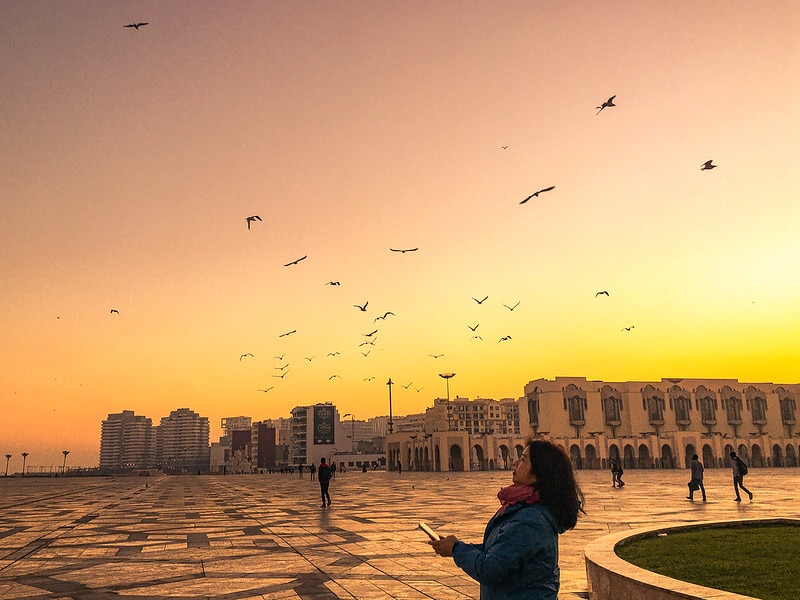Alice Elliot’s monograph The Outside: Migration as Life in Morocco skilfully uses ethnography to unsettle mainstream conceptualisations of migration by tracing its hold on everyday life in what would be routinely called a ‘sending’ community. Set in the Tadla, a rural area of Central Morocco with one of the country’s longest (and apparently most stigmatised) histories of emigration, the monograph centres on the concept-cum-social force of ‘the outside’ (l-brra). Straddling both an ethnographic term and a theoretical concept, l-brra emerges as a complex yet slippery notion unfolding in the lives of those who leave, and, most strikingly, also in the lives of those who stay. By focusing on the relentless presence of ‘the outside’ in the Tadla, Elliot offers insight into the effects of migration on those frequently (and pejoratively) considered ‘left behind’. Instead, l-brra takes shape and, in turn, shapes the imaginations, daily concerns, relationships, and very personhoods of Elliot’s so-called ‘non-migrant’ interlocutors.
At the outset, Elliot outlines three conceptual functions of l-brra: as part of a wider cosmology and imagination governing life in the Tadla, as a practical force with significant impacts in everyday life (from the tyranny of bureaucracy to intimate gestures between spouses), and, finally, as wholly contingent on the context from which it emerges. Throughout the monograph, Elliot combines these conceptual aims with a varied range of scholarship, not only of migration, but also of gender, kinship, temporality, and theology, to list but a few. This broad theoretical brushstroke is one of the volume’s strengths, perhaps unsurprising given its sincere commitment to ethnography. The breadth of literature echoes the volume’s overarching argument that l-brra weaves itself into the textures and relationships of everyday life in the Tadla.
Her central focus on the narratives of ‘non-migrant’ women is another theoretical and ethnographic triumph of the volume, as it centres these oft missed voices from studies of migration as a ‘male affair’ (pp. 21).
When describing her fieldwork, Elliot labels it as inherently mobile—in her words, ‘multihousehold’ (pp. 18) rather than merely multisited—and shaped by a ‘disarming hospitality’ (pp. 15) as she takes the reader across the doorsteps of multi-generational family households, into student dorms, and on trips to Western Union branches. Her main interlocutors are mostly women from modest rural families whose close relatives live abroad, although she includes many other voices, such as her student dormmates, migrant men during their return trips, and non-migrant men or elders in awe and contempt of the latter. Her central focus on the narratives of ‘non-migrant’ women is another theoretical and ethnographic triumph of the volume, as it centres these oft missed voices from studies of migration as a ‘male affair’ (pp. 21). Eliott does not let herself be discouraged by this, but turns it on its head by writing a unique monograph about migration largely ‘in the absence’ (pp. 21) of the mobile, male protagonists.
The book is structured into six chapters reunited by the empirical and conceptual presence of l-brra. Chapter 1 considers the temporality of l-brra, as critical encounters with ‘the outside’ shape the structuring and pace of life in the Tadla. Attending to the changing rhythms of these encounters shows the multiple, competing temporalities involved in migration and the disordering nature of time. ‘Dead’ time becomes slow and leaves people in the Tadla stuck and waiting, before speeding up and burning in anticipation of a potential departure or a long-awaited return. These temporal effects of l-brra irreversibly intersect with movement across different spaces and scales, as agitating households in the Tadla reverberate with the movements of migrants’ relatives to and from the city, and with migrants’ crossings across the sea. In particular, we see how the materialisation of l-brra significantly affects the ‘tempo of kinship’ (pp. 32) as engagements and weddings are structured according to the bureaucratic timelines and political contexts of migrants’ lives in Italy. Outside of these extraordinary events, the temporal qualities of ‘the outside’ impact the intimate relationships of love and care unfolding in the everyday, as dutiful wives prepare for their migrant husbands’ return with visits to the souk or the hammam. Following the theme of migrants’ return, Chapter 2 focuses on how migrant men embody and become transformed by l-brra, which in turn impacts how they are perceived during their holidays in the Tadla. Multivocal, at times contradictory, storytelling turns a brush with ‘the outside’ into ‘a mixed blessing’ (pp. 50), as migrants’ morality is subject to scrutiny by those who stay. A moral exceptionalism envelops migration in these narratives, serving as an unreliable pivot between pride and cleverness or between courage and madness. Migrants’ offensive displays of wealth and status prove unsettling during their return to the Tadla, often seen as ‘animal like’ in the eyes of elders or unmarried educated men (pp. 58). Despite these contested moral norms, l-brra has the power to qualify people above their rural origins, which Elliot shows most evocatively at play in marriage arrangements. In marriage offers from migrant men, their status of having been in ‘the outside’ trumps their social origins, their family background, and their illiteracy or lack of education. Besides their ability to offer more generous bridewealth payments, migrants are transformed by l-brra itself, as it impacts the very substance of their personhood.
L-brra once again serves to undo preconceived ideas about the women’s desires as simply being for all things Western or a mere rejection of traditional forms of life. Instead, ‘the outside’ helps situate their desire within the context of their lives, one which is irreversibly marked by the presence and possibility of migration.
Chapter 3 shifts focus to explore the shadows cast by l-brra in the lives of migrants’ wives as they proclaim to be married to ‘the outside’ itself, rather than to their husbands, a relationship which Elliot terms one of ‘intimate distance’ (pp. 73). Similar to the previous chapter, ‘the outside’ serves to modify not only gender relations and norms, but it also creates a specific, precarious gendered personhood. Forged in the ‘productive absence’ (pp. 76) of their husbands, this personhood emerges out of women’s roles as wives without husbands. The most striking setting is co-habitation with affines where women must juggle what Elliot calls a ‘triangle of forces’ (pp. 84): the expectations of their affines, the pull of their own blood ties, and the social force of l-brra. Most importantly, this chapter counters the view in migration and development studies which neatly equates migration with empowerment, showing how ‘the outside’ places new burdens on women’s shoulders, such as interactions with the masculine spaces of local bureaucracy. At times, l-brra also marks a life that is lacking and painfully different, for instance by the delayed bearing of children or by the year-long waiting to join husbands in ‘the outside’. Retaining a focus on women, Chapter 4 explores another manifestation of l-brra in women’s lives as it sits at the centre of the strategised, yet predestined, conjugal futures for young women studying at university. For the young students with whom Elliot shares a dorm room, ‘the outside’ emerges as a pre-destined future orientation. Rather than imagining a future simply in the geographical space of ‘the outside’, the women desired conjugal bonds marked by privacy and openness, notions they associated with l-brra. Most strikingly, destiny is shown to beckon, rather than hinder, action in the young women’s lives. The tension between notions of Islamic destiny and work on the self is beautifully explored as women prepare themselves to meet their pre-destined husbands by continuing their education, piously safeguarding and regulating their sexuality, and engaging in beauty rituals. During walks around the medina, young women grow accustomed to judging possible suitors by their stance, clothes, and manners in order to find their pre-ordained husband. L-brra once again serves to undo preconceived ideas about the women’s desires as simply being for all things Western or a mere rejection of traditional forms of life. Instead, ‘the outside’ helps situate their desire within the context of their lives, one which is irreversibly marked by the presence and possibility of migration.
Returning to the figure of migrant men, Chapter 5 focuses on the crossing, the mobility between l-brra and the Tadla, and how repeatedly engaging in it serves to perform and re-enact masculinity. Rather than a one-off rite of passage, migration emerges as an exercise of maintaining and performing a gendered identity under a changing set of circumstances. To avoid being accused of ‘sitting like a woman’ (pp. 123), migrant men must engage in designated activities, such as building houses or investing in a new business, upon their temporary return to the Tadla. Continuing to trace the effects of ‘the outside’ on gender, these masculine activities are expected to be made grander, more ingenious, and eccentric by the encounter with l-brra. Chapter 6 concludes the monograph by revisiting how l-brra holds ‘sui generis ontological characteristics in the Tadla’ (pp. 148) as it has been shown to impact the everyday lives, bodies, relationships, and imaginaries of Elliot’s interlocutors. Grappling with the cosmological and ontological aspects of l-brra, Elliot emphasises that the social power of the concept does not fit neatly into theological parallels. Similarly, the concept does not simply amount to an imaginary notion, as it has significant impacts in people’s lives – whether in the bodies and masculinities of migrant men, the lives and bodies of their migrant wives, or the animated anticipation of young students waiting to meet their predestined migrant husbands. Elliot concludes that l-brra therefore occupies a ‘middle ground’ between cosmology and geography (pp. 156). And ultimately, it is best understood ‘in action’ (pp. 156).
Outside of migration studies, the monograph is a stunning example of the craft of ethnographic writing, marked by a sensibility honed through continuous engagement and caring relationships in the Tadla over the years.
Doing justice to this commitment to understanding l-brra in action, ‘The Outside’ opens up the concept of migration and uses ethnography to unsettle preconceived ideas and epistemologies about how to best understand and document experiences of mobility. It emerges as a formidable asset for those teaching migration, with a potential to show students the manifold impacts of migration in a setting formally considered ‘left behind’ or ‘non-migrant’. Outside of migration studies, the monograph is a stunning example of the craft of ethnographic writing, marked by a sensibility honed through continuous engagement and caring relationships in the Tadla over the years. It is the process of building this sensibility that is partly missing from the volume, which would benefit from more insight into the positionality of the author. Although it is briefly referenced in the introduction, more reflection on how the ethnographer’s positionality impacts the material and the relationships at the heart of the monograph would help the reader better situate these encounters. Another potential shortfall is the limited sustained engagement with key interlocutors which could perhaps show how the influence of l-brra changes over the years. That being said, Elliot’s monograph goes above and beyond most studies of migration by using the power of ethnography to shine a light onto the seemingly mundane yet remarkable hold of ‘the outside’ for both those who go and those who never set off across the sea.



